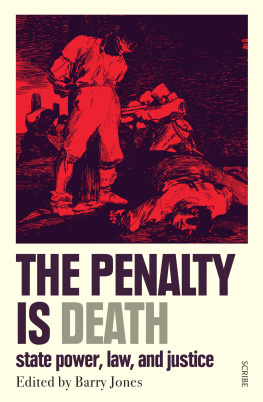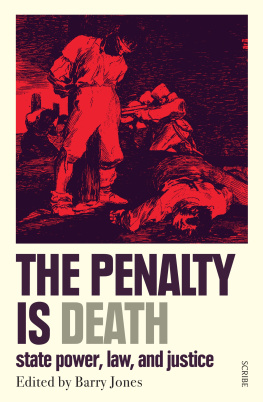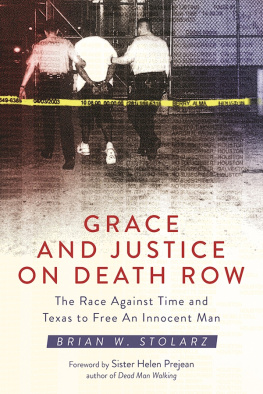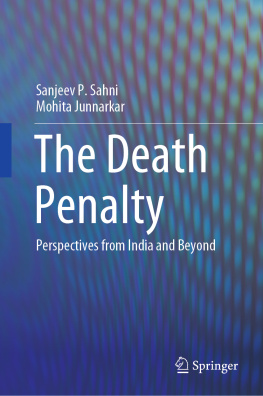DEATH
AND
JUSTICE
AN EXPOS OF OKLAHOMAS DEATH ROW MACHINE
MARK FUHRMAN

FOR MY SON AND DAUGHTER
CONTENTS
INTRODUCTION
WELCOME TO DEATH ROW
THEY CALL OKLAHOMA STATE PENITENTIARY AT MCALESTER THE WALL, and once you see it, you know why. At the entrance to the prison grounds, theres a high, wide wall with guard towers at each corner. The Wall is made of brick that has been painted white so many times the paint itself has become part of its structural integrity. Some of the arches are beginning to sag or lean, but The Wall isnt coming down.
I had come to McAlester to visit death row. I was researching the death penalty. There had been a series of high-profile releases of inmates from death row, several of them in Oklahoma, and I wanted to find out exactly what happened and why. The media has a way of simplifying crime stories so that they stray further and further from the truth the more attention is paid to them.
At first I suspected that most of the inmates released from death row might actually have been guilty of the crimes for which they were convicted. Id seen it before. All convicts claim they are innocent, and sometimes their defense attorneys get their cases reversed on a technicality. Yet in several recent death row releases, there had been evidence like DNA that could not be dismissed as a technicality. Since 1977, more than one hundred inmates have been released from death row in the United States. Many of them had arguable claims of innocence. Some had clearly been railroaded, perhaps even intentionally framed.
Was there something wrong with the death penalty? I decided to look into it myself. As I looked at individual cases in isolation, I saw some terrible miscarriages of justice. Police had fabricated confessions. Criminalists had lied or enhanced evidence. Prosecutors had cut corners. I wanted to understand how this happened and why. So I decided to focus on one jurisdiction and examine several cases together, looking not just at innocent people who had been convicted but also at guilty suspects. I felt that the answer would lie not in the isolated cases but in the entire process itself. From arrest to execution over a period of several years and many different cases, I wanted see how the death penalty worked.
Oklahoma executed twenty-one convicts in 2001more than any other state. Thirteen of those executed had been tried and convicted in one county by one district attorney. Oklahoma City, a relatively small jurisdiction, was producing an extraordinary number of death penalty convictions (and two innocent men had been released from death row). Oklahoma County, which encompasses Oklahoma City, seemed like a good place to conduct my investigation. I hoped to reach some conclusions about the death penalty.
I arrived at McAlester on Good Friday morning in 2002. It was the first day that felt like spring, and dozens of inmates on low-security work detail were out mowing the lawns and raking up the clippings. The smell of freshly cut grass and clover filled the air. All the lawns are well maintained. Everything is painted white. Even the inmates wear white pants and T-shirts that are white, except for the word inmate printed on the back. It was only nine oclock and already warm. Their T-shirts were soaked with sweat.
You have to remind yourself that these people are convicted criminals. Dont make eye contact. Dont get too close to them physically. Watch your back, just in case. Because theres another wall, the one that prison makes you put up between yourself and othersdont show any emotion, any weakness, any sympathy, or any fear. If you do, someone will take advantage.
The people who work at McAlester never let themselves forget why the inmates are there. Outside The Wall is a collection of houses for prison administrators and employees, a neighborhood of sorts. The administrators drive from their nearby houses to their assigned parking spaces and stay, as much as they can, in their offices. When I arrived, no one was outside except the inmates and an occasional corrections officer. I didnt see anybody who looked like a civilian resident. A nearby playground was empty.
Construction on McAlester began soon after Oklahoma achieved statehood in 1907, and the main building was finished in 1909 by inmates who lived in what are now the stables for the prison rodeo. The prison is well maintained: everything that can be polished or trimmed or painted has been. Across from the main entrance is the wardens residence, a sprawling house, a mansion in fact.
In front of the main entrance is a chain-link fence and a guard tower of white-painted brick. A guard stood in the tower, surveying the outside grounds from behind the tinted glass. I could feel him watching me as I walked up the stairs with my partner, Stephen Weeks.
I was on the guards side. We were both members of the law enforcement community. Still, I felt a chill on my back as he watched me.
Climbing the steps, we passed a young girl walking down from visitor processing. She was around eleven years old, the age at which girls first start looking like the women they will become. (I have a daughter the same age.) This girl was pretty, with dark features. Her brown hair was tied back neatly into a bun. She wore a brand-new Easter dress but on her feet were dirty sneakers with no socks. The girl must have been visiting her father, and maybe her mother sent her back to the car to wait. Her eyes were wet and reddened, but when she saw me looking at her, she set her facestubborn, almost proudstared straight ahead, and walked deliberately down the concrete steps toward the guard tower. She was not going to let anyone see her cry.
Our contact at the prison was Lee Mann. Her official title is spokesperson, but she handles a variety of functions, including fielding media questions and requests, dealing with family members of inmates, and presenting the public face of McAlester to the world outside. Ms. Mann is an attractive woman, tall and slim, with short white hair. Her manner is candid and direct, even warm. She could be the tour guide at a dead presidents home instead of a maximum-security prison. Inside her office the decor was civil-service functional, aside from a collection of baseball caps from local homicide divisions, and any posters or pictures were generic. This was a room where inmates families, maybe sometimes inmates themselves, would come. Nothing personal, nothing human.
Lee Mann led us back outside, and we waited beneath the front tower while the guard lowered down a set of keys in a gray plastic bucket at the end of a long, knotted piece of rope. These were the keys to the deputy wardens minivan, which would take us to H-Unit, the maximum-security block of McAlester, where the death row inmates are housed.
H-Unitlock-down, supermax, whatever you want to call itwas built in 1990, following a violent prison riot in 1985, during which guards were taken hostage and several of them seriously injured. I talked to several prison employees who were there in 1985. They showed me pictures of the riotinmates swarming the yard, guards bloody and bound. The prison museum has a collection of shivs and other weapons taken from the rioters. Having survived one nightmare, the Oklahoma Department of Corrections decided not to risk another. So they built H-Unit.
Designed by a prison committee to create a supermaximum facility in which physical contact between inmates and staff was kept to a minimum by a series of elaborate electronic security features, H-Unit is almost entirely constructed of steel and concrete, an earth-sheltered facility rising up out of the ground like some kind of huge root cellar.







